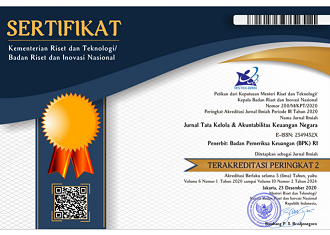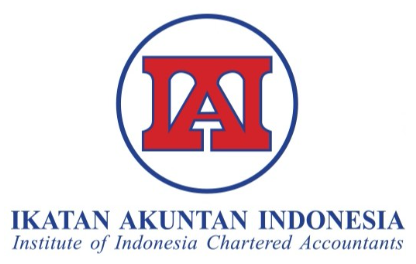The Lack of a Strong and Accountable Public Procurement Ecosystem in West Papua to Prevent Corruption
DOI:
https://doi.org/10.28986/jtaken.v9i1.1346Keywords:
ecosystem, Public Procurement, West Papua, tenderAbstract
West Papua has a relatively high risk of corruption during the implementation of its public procurement. It is critical to recognize that public procurement business processes are analyzed as an ecosystem with interactions between actors. This research aims to determine the need for a conducive ecosystem for public procurement (PBJP) in the West Papua province and propose recommendations for improving or increasing the credibility of public procurement. This research is qualitative because primary data are obtained through interviews and forum group discussions with selected participants. The results of the study show that the public procurement ecosystem consists of Budget User Authorities (KPA) or Contract Officers (PPK), Working Units for Public Procurement (UKPBJ), Vendors, Internal Control, and Regulators who are credible procurement actors as focal offers. Examining each actor's issues has led to the conclusion that to boost the credibility of public procurement goals. It is necessary to strengthen leadership commitment, improve the quality of human resources, and simplify laws. The research findings are expected to assist practitioners and policymakers in understanding why there is a lack of public procurement ecosystem in West Papua and propose the necessary corrective policies.
References
Adi, C. S. (2017). Analisis penerapan e-procurement menggunakan sistem pengadaan secara elektronik: Studi kasus pada Layanan Pengadaan Secara Elektronik (LPSE) Kementerian Keuangan Papua Barat. Indonesian Treasury Review: Jurnal Perbendaharaan, Keuangan Negara, dan Kebijakan Publik, 2(2), 1–16.
Azwar, A. (2016). Peran alokatif pemerintah melalui pengadaan barang/jasa dan pengaruhnya terhadap perekonomian Indonesia. Kajian Ekonomi Dan Keuangan, 20(2), 149–167. DOI: 10.31685/kek.v20i2.186
Bergman, M. A., & Lundberg, S. (2013). Tender evaluation and supplier selection methods in public procurement. Journal of Purchasing and Supply Management, 19(2), 73–83. DOI: 10.1016/j.pursup.2013.02.003
Braun, V., & Clarke, V. (2006). Using thematic analysis in psychology. Qualitative Research in Psychology, 3(2), 77–101. DOI: 10.1057/978-1-137-35913-1
Budiratna, H., & Qibthiyyah, R. M. (2020). Evaluasi atas transfer dana otonomi khusus di Aceh, Papua, dan Papua Barat. Jurnal Indonesia Sosial Sains, 1, 402–414.
Costa, A. A., Arantes, A., & Tavares, L. V. (2013). Evidence of the impacts of public e-procurement: The Portuguese experience. Journal of Purchasing and Supply Management, 19(4), 238–246. DOI: 10.1016/j.pursup.2013.07.004.
Cresswell, J. D. (2014). Research design: Qualitative, quantitative and mixed methods approach (B. Brittany (ed.); 4th ed.). SAGE Publications Ltd.
DJPK. (2022). Alokasi Dana Otsus dan DTI TA.2021 dan TA.2022 per Kab/Kota. Retrieved from https://djpk.kemenkeu.go.id/wp-content/uploads/2021/12/ALokasi-Dana-Otsus-dan-DTI-2021-dan-2022.pdf
Hawley, A. H. (1988). Human ecology. The University of Chicago Press.
Johantri, B., & Aprilia, R. (2021). Penawaran harga pekerjaan konstruksi pemerintah di era pandemi (Studi empiris pada Kementerian Keuangan). Jurnal Manajemen Keuangan Publik, 5(1), 66–80.
Kapoor, R. (2018). Ecosystems: Broadening the locus of value creation. Journal of Organization Design, 7(1). DOI: 10.1186/s41469-018-0035-4
Kapoor, R., & Lee, J. M. (2013). Coordinating and competing in ecosystems: How organizational forms shape new technology investments. Strategic Management Journal, 34(3), 274–296. DOI: 10.1002/smj.2010
Khairina, E., & Dompak, T. (2022). Tinjauan terhadap e-procurement di Indonesia. Dialektika Publik, 6(1), 15–22. DOI: 10.33884/dialektikapublik.v6i1.5464
Klitgraad, R. (1988). Controlling corruption. University of California Press.
Komisi Pemberantasan Korupsi. (2021). Integrity survey index. Survey Penilaian Integritas. Retrieved from https://jaga.id/jendela-pencegahan/spi?vnk=6d6e81b9
Kurniawan, M. R., & Pujiyono, P. (2018). Modus operandi korupsi pengadaan barang dan jasa pemerintah oleh PNS. Law Reform, 14(1), 115. DOI: 10.14710/lr.v14i1.20241
Lehman, G., & Morton, E. (2017). Accountability, corruption, and social and environmental accounting: Micro-political processes of change. Accounting Forum, 41(4), 281–288. DOI: 10.1016/j.accfor.2017.10.004
LKPP. (2022). Dashboard SIRUP 2022. Retrieved from https://datastudio.google.com/u/1/reporting/4482ff4e-f62b-4454-98eb-7ebae94e3401/page/IjAmC
Lloyd, R. E., & McCue, C. P. (2004). What is Public Procurement? Definitional Problems and Implications. International Public Procurement Conference, 3(9), 1689–1699.
Mansawan, I. (2021). Efektifitas implementasi Perpres No. 17 Tahun 2019 tentang Pengadaan Barang/jasa pemerintah dalam mempercepat pembangunan di Propinsi Papua Barat. (Unpublished master’s thesis). Hasanuddin University, South Sulawesi, Indonesia.
Mentzer, J. T., DeWitt, W., Keebler, J. S., Min, S., Nix, N. W., Smith, C. D., & Zacharia, Z. G. (2001). Defining supply chain management. Journal of Business Logistics, 22(2), 1–25. DOI: 10.1002/j.2158-1592.2001.tb00001.x
Mohungoo, I., Brown, I., & Kabanda, S. (2020). A systematic review of implementation challenges in public e-procurement. Responsible Design, Implementation, and Use of Information and Communication Technology, (April), 46–58. DOI: 10.1007/978-3-030-45002-1_5
Moore, J. F. (1993). Predators and prey: A new ecology of competition. Harvard Business Review, 71(3), 75–86.
Murray, J. G. (2009). Improving the validity of public procurement research. International Journal of Public Sector Management, 22(2), 91–103. DOI: 10.1108/09513550910934501
Nani, D. A., & Ali, S. (2020). Determinants of effective e-procurement system: Empirical evidence from Indonesian local governments. Jurnal Dinamika Akuntansi dan Bisnis, 7(1), 33–50. DOI: 10.24815/jdab.v7i1.15671
Pavic, I., Galetic, F., & Piplica, D. (2016). Similarities and differences between the CR and HHI as an indicator of market concentration and market power. British Journal of Economics, Management & Trade, 13(1), 1–8. DOI: 10.9734/bjemt/2016/23193
Peleckis, K. (2022). Determining the level of market concentration in the construction sector — case of application of the HHI index. Sustainability, 14, 779.
Porter, M. (1985). Competitive advantage creating and sustaining superior performance. The Free Press.
Porter, M. E., & Linde, C. V. D. (1995). Toward a new conception of the environment-competitiveness. Journal of Economic Perspectives, 9(4), 97–118.
Presidential Regulation Number 12 of 2021 concerning Amendments to Presidential Regulation Number 16 of 2018 concerning Government Procurement of Goods/Services (Peraturan Presiden Nomor 12 Tahun 2021 tentang Perubahan atas Peraturan Presiden Nomor 16 Tahun 2018 tentang Pengadaan Barang/Jasa Pemerintah). Retrieved from https://peraturan.bpk.go.id/Home/Details/161828/perpres-no-12-tahun-2021
Puspita, A. C., & Gultom, Y. M. (2022). The effect of e-procurement policy on corruption in government procurement: Evidence from Indonesia. International Journal of Public Administration, 45(15). DOI: 10.1080/01900692. 2022.2093900
Rakhel, T. M., & Putera, P. B. (2021). Corruption in public procurement: A bibliometric analysis. COLLNET Journal of Scientometrics and Information Management, 15(2), 397–412. https://doi.org/10.1080/09737766.2021.1989990
Regulation of National Public Procurement Agency Number 12 of 2021
Concerning Guidelines for Implementation of Government Procurement of Goods/Services Through Providers (Peraturan Lembaga Kebijakan Pengadaan Barang/Jasa Pemerintah Nomor 12 Tahun 2021 tentang Pedoman Pelaksanaan Pengadaan Barang/Jasa Pemerintah Melalui Penyedia). Retrieved from https://jdih.lkpp.go.id/regulation/peraturan-lkpp/peraturan-lkpp-nomor-12-tahun-2021
Sirait, B. C. (2018). Memotret e-procurement dalam mewujudkan good governance di Indonesia. Journal of Governance, 3(1). DOI: 10.31506/jog.v3i1.3081
Sukmalalana., Ramadhan, F., Pdihegso, A. Y., Huda, F. N., & Fadli, S. D. (2020). Akuntabilitas Dana Otsus Papua Provinsi Papua dan Papua Barat. Jakarta: Pusat Kajian Akuntabiltas Keuangan Negara.
Thai, K. V. (2009). International Handbook of Public Procurement. Retrieved from https://ftp.idu.ac.id/wp-content/uploads/ebook/ip/BUKU%20PROCUREMENT/international%20handbook%20of%20Public%20Procurement.pdf
Tuanakotta, T. M. (2017). Akuntansi forensik dan audit investigasi (2nd Ed.). Jakarta: Salemba Empat.
Vaidya, K., & Campbell, J. (2016). The multidisciplinary approach to defining public e-procurement and evaluating its impact on procurement efficiency. Information Systems Frontiers, 18(2), 333–348. DOI: 10.1007/s10796-014-9536-z
Warouw, S., Nangoy, G., & Runtu, T. (2016). Analisis penggunaan Dana Otonomi Khusus pada Pemerintah Kota Sorong di Papua Barat. Jurnal Berkala Ilmiah Efisiensi, 16(01), 627–637.
Williams-Elegbe, S. (2018). Systemic corruption and public procurement in developing countries: are there any solutions? Journal of Public Procurement, 18(2), 131–147. DOI: 10.1108/JOPP-06-2018-009
Downloads
Submitted
Accepted
Published
How to Cite
Issue
Section
License

Jurnal Tata Kelola dan Akuntabilitas Keuangan Negara is licensed under
a Creative Commons Attribution-ShareAlike 4.0 International License




















